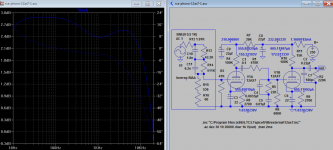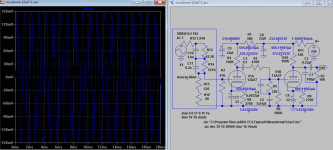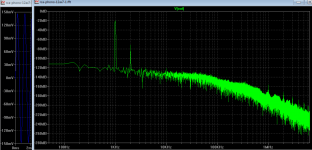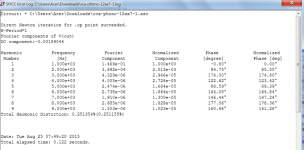Here are the results. Overall gain drops by about 13db more below 15hz, 1Khz gain drop from 70mV to 15mV but distortion remains same as ~0.05%
I'm not sure what you mean there. I see 0.5V at the input, so how are you getting only 70mV out?
I usually quote the distortion of the sim at 1V rms (1.414V peak) output at the [out] node.
To measure changes in gain, I'll keep the output at 1V rms and record the change in input voltage required to get to that 1V rms output voltage.
Try this spice directive to get an FFT plot:
Code:
.tran 0 0.17 0.15 1u
.four 1k 10 v(out)Also, if the input voltage remains constant, a drop from 70mV out to only 15mV out represents a difference of -35dB, right? At least I think that's right...
--
Last edited:
I'm not sure what you mean there. I see 0.5V at the input, so how are you getting only 70mV out?
I usually quote the distortion of the sim at 1V rms (1.414V peak) output at the [out] node.
To measure changes in gain, I'll keep the output at 1V rms and record the change in input voltage required to get to that 1V rms output voltage.
Try this spice directive to get an FFT plot:
Also, if the input voltage remains constant, a drop from 70mV out to only 15mV out represents a difference of -35dB, right? At least I think that's right...Code:.tran 0 0.17 0.15 1u .four 1k 10 v(out)
--
I just deduct those figures viewing the response curve, not really calculated. The input is at lower tap of 600 ohms (now on higher tap) inversed RIAA pad on the left hence the loss is more in the pad with input of 500mV and only 5mV at grid of V1A, loss of 100 and front stage gain of only 3 and output stage of 10, give overall gain 30 minus the pad, net loss 70. That for 10K load, with 220K the output is 680mV so gain 680/15=45, a gain loss of 35 compared to 10K. 20(log35)=30db.
Here are the requests, I too learn something, what is your comment?
Attachments
Last edited:
...
I usually quote the distortion of the sim at 1V rms (1.414V peak) output at the [out] node.
To measure changes in gain, I'll keep the output at 1V rms and record the change in input voltage required to get to that 1V rms output voltage.
...
--
I don't think 12AX7 can take input 1V rms, I tried it very distorted, so can not meet your request. Anyway RCA circuit says 3mV for 0.55V output implied for low level input, and overall gain 183 is bit higher than ours sim of 3 *45=135 at 220K load and 45 at 10K load (the first stage gain is taken at gird input to V1B, gain 50 at V1A anode). There are others circuit with less loss, then distortion maybe higher too. Now distortion 1K at 10K load is about 0.25%.
Edit: Sorry mistaken, 1V RMS out, not in ok, 1.9% distortion @1K, 10K load, 0.18% 220K load.
Attachments
Last edited:
I just deduct those figures viewing the response curve, not really calculated. The input is at lower tap of 600 ohms (now on higher tap) inversed RIAA pad on the left hence the loss is more in the pad with input of 500mV and only 5mV at grid of V1A, loss of 100 and front stage gain of only 3 and output stage of 10, give overall gain 30 minus the pad, net loss 70. That for 10K load, with 220K the output is 680mV so gain 680/15=45, a gain loss of 35 compared to 10K. 20(log35)=30db.
....
Another mistake, gain loss should be = 20*log(45/10) = 13db same as view from the response curves.
- Status
- This old topic is closed. If you want to reopen this topic, contact a moderator using the "Report Post" button.



